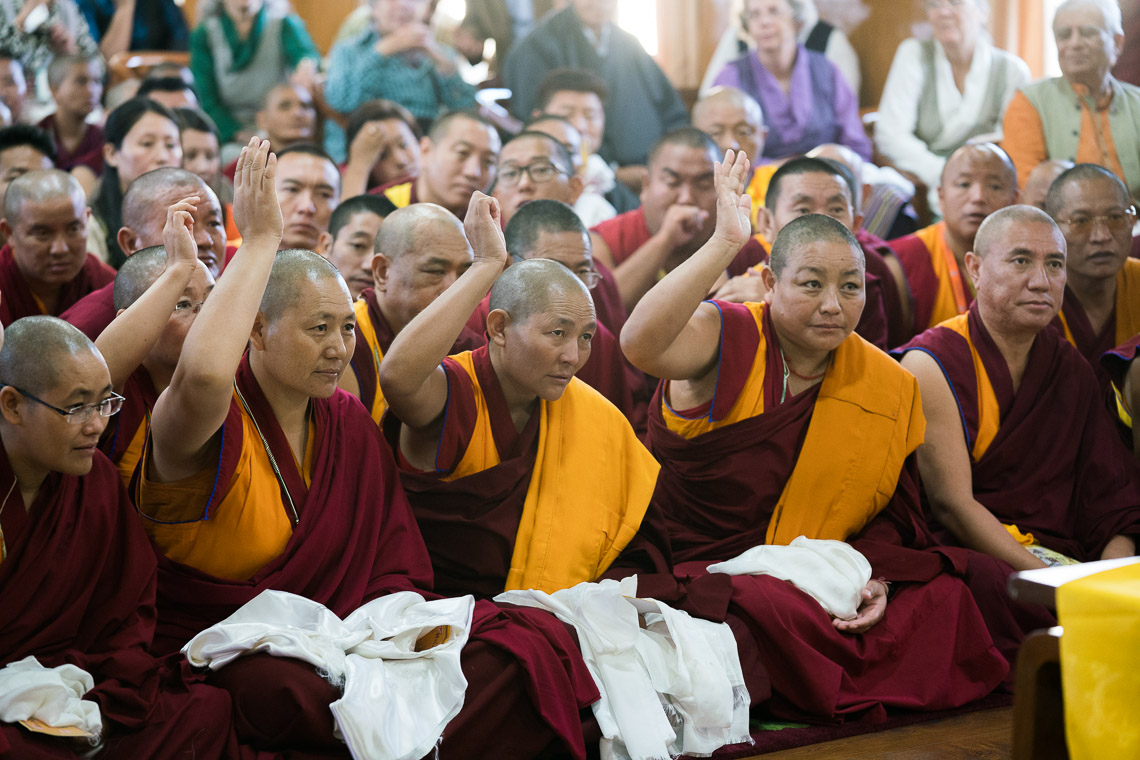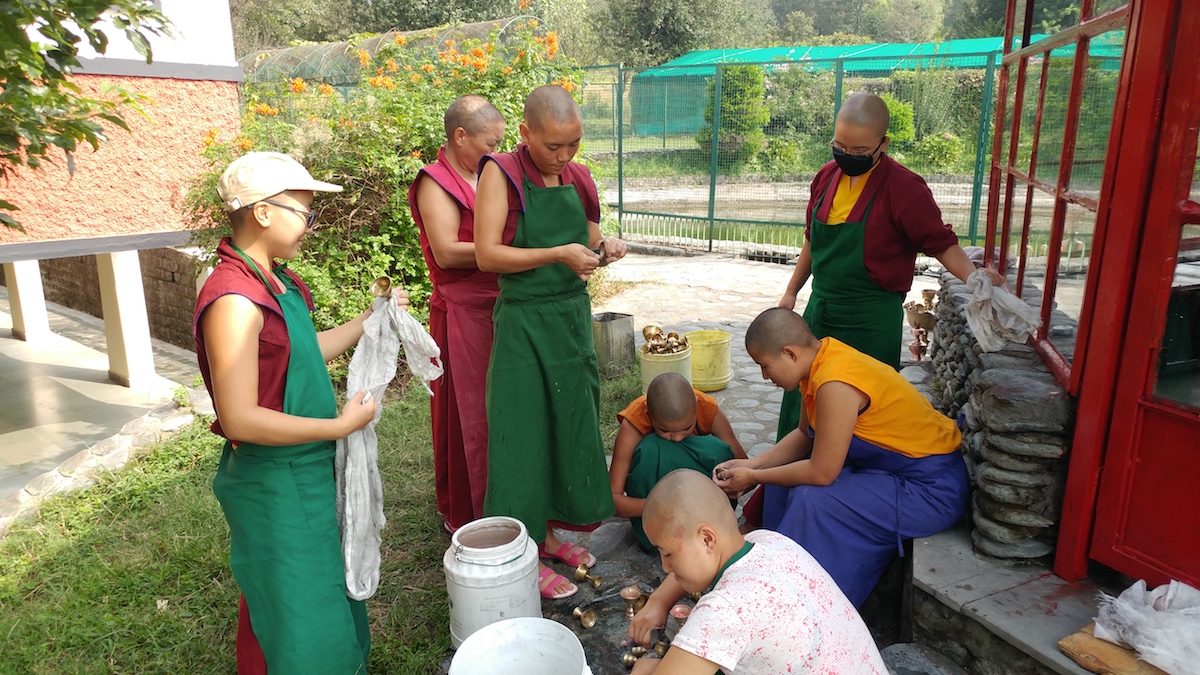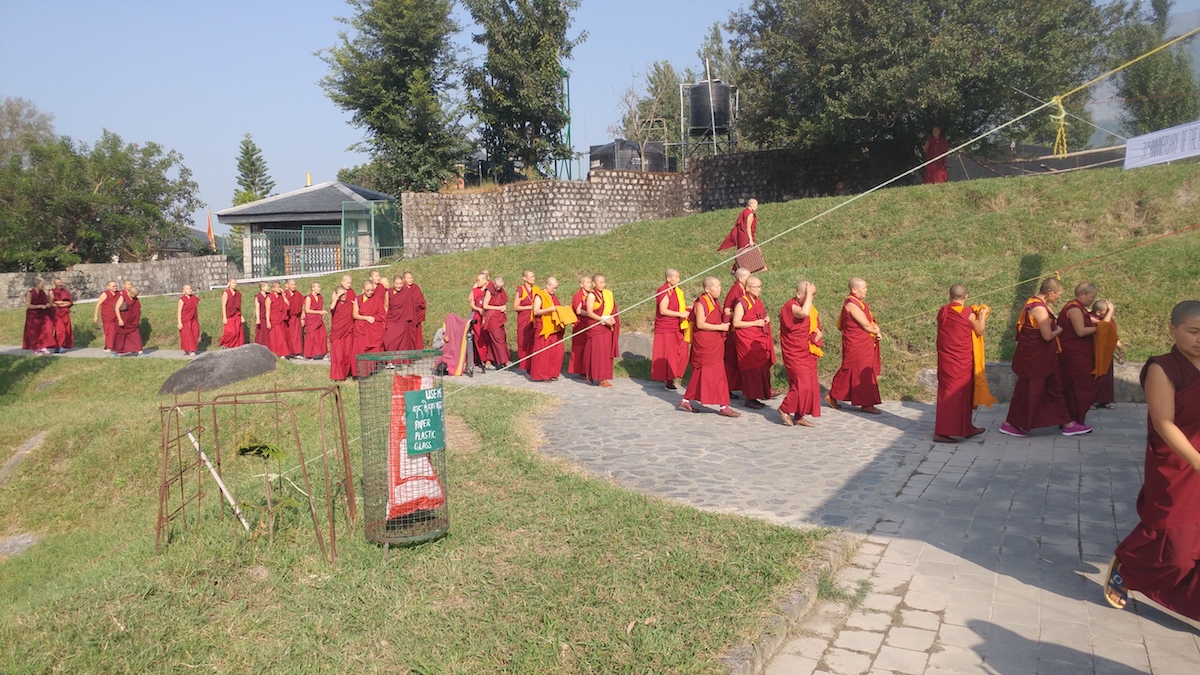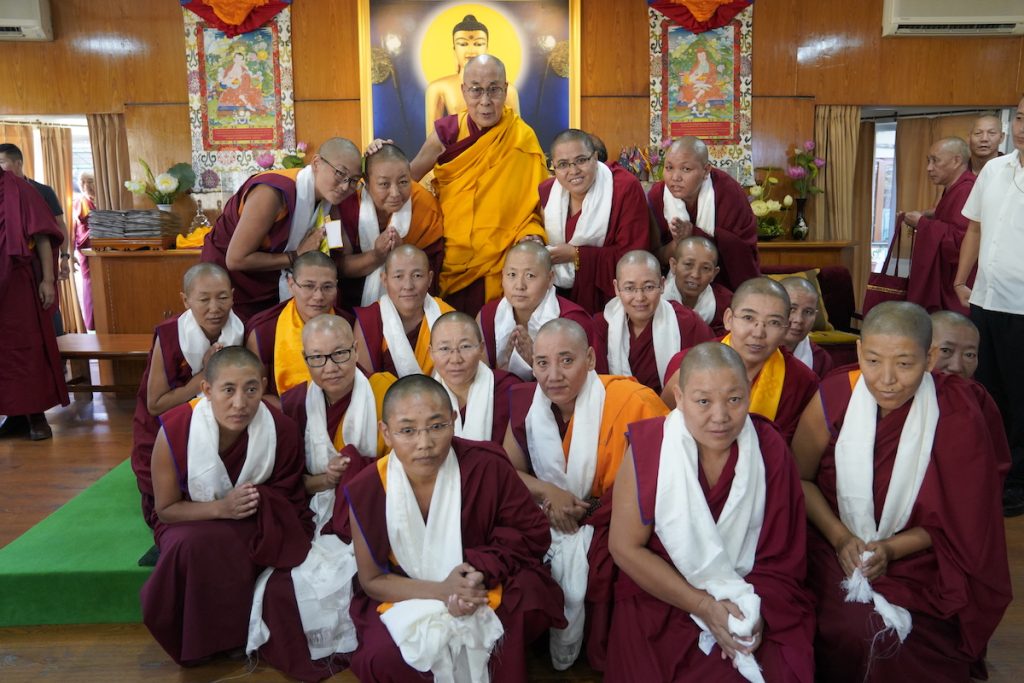Editor’s note: Steve Wilhelm serves on the Tibetan Nun Project’s board.
The Dalai Lama is happy that a group of 20 Tibetan Buddhist nuns have earned geshema degrees, a high level of scholarship previously reserved only for male monks.
“I am very proud of your achievement,” said His Holiness the Dalai Lama during an audience with about 40 leading nuns and monks in the mountain town of Dharamsala, India, on October 4, 2017. “Among Buddhist countries, this is the only one [referring to the diaspora of Tibetans around the world] with women in the highest level of Buddhist scholarship.”
The Dalai Lama spoke in a room adjacent to his residence in Dharamsala. The event was part of the weeklong celebration of the 30th anniversary of Tibetan Nuns Project, which funds the education of nearly 750 Tibetan nuns, mostly in India.
In 2016, these 20 women became the first Himalayan-origin Tibetan nuns to earn the geshema degree in Tibetan Buddhism’s 1,200 year history. Until now, these highest degrees—the equivalent of doctorate degrees in the West—have only been awarded to male monks, called geshes. Another six nuns successfully completed their geshema exams in 2017.

This series of nuns passing the grueling four-year exams is a particular triumph for Tibetan Nuns Project.
The organization, with twin headquarters in Dharamsala and Seattle, has supported and educated Tibetan nuns for the last 30 years.
From the start, Tibetan Nuns Project has focused on lifting nuns’ level of scholarship to a level equal that of male monks. In his remarks, the Dalai Lama celebrated that accomplishment.
After a long preamble during which he built a case that Buddhist thinking is built more on “logic and reasoning” than faith, he said the rigor of the geshema training has uniquely prepared these women to communicate Buddhist thinking to others.
“You have a huge responsibility to spread Buddhist philosophy and science among other communities,” he said.
The Dalai Lama linked his remarks to Tibetan Nuns Project because of the pivotal role the organization has played in supporting and training the nuns, many of whom are refugees from Chinese-occupied Tibet.
Tibetan Nuns Project was founded in 1987, after monastics started flooding across the border into India, many of them traumatized by repression in Tibet by the Chinese government. While refugee monks were absorbed into existing monastic institutions in India and Nepal, most of the nuns had nowhere to go.
“We got busy in seeing what we can do for the nuns,” remembers Rinchen Khando Choegyal, director of Tibetan Nuns Project, and sister-in-law of the Dalai Lama. “We didn’t know where to start.”
The organization has built a deep funding network over 30 years that has made the nuns’ education possible.
Tibetan Nuns Project has steadily grown and now supports nuns in seven nunneries around the Dharamsala region, as well as in more isolated areas.
Choegyal repeatedly expressed her gratitude for the generosity of donors, who have funded construction of several of the nunneries from the ground up.

Seven of the first 20 geshema graduates came from Tibetan Nuns Project-backed nunneries, more than any other institution. Two of the six who passed the 2017 exams also came from affiliated nunneries, and one of them earned the highest score possible in the round of examinations.
It was the pivotal role of Tibetan Nuns Project in the first geshema degrees that attracted the Tibetan government’s Prime Minister Lobsang Sangay to a daylong 30th anniversary celebration on October 2. That celebration, in the large debate courtyard behind Tibetan Nuns Project’s largest nunnery, Dolma Ling, attracted hundreds of local and foreign supporters.
In his remarks, Sangay said he considers himself “lucky and honored” that the anniversary—and the increasing number of geshema degrees—are happening during his administration. He cited the organization’s “small beginnings,” adding that the anniversary is a major and historic achievement.
“You all wanted to empower women, to have nuns on an equal footing with monks,” he said. “You all through determination worked very hard and made it possible.”
He said he is proud of the “very high quality” of the geshemas’ training, adding that he expects them to have an important role in training others in Buddhism.
“This is part of Tibetan women’s empowerment, and we are in the forefront of the advancement of women in Tibetan society,” he said.
While male monks still do most of the training at nunneries supported by Tibetan Nuns Project, the first cohort of geshemas are already moving into teaching roles.
At Genden Choeling Nunnery, which after 47 years is one of the oldest nunneries in the region, one geshema is now teaching philosophy to other nuns, said Rhuntsok Tsultrim, abbot of the nunnery. Perched on the precipitous eastern edge of the mountain village of McLeod Ganj, Ganden Choeling is home to 190 nuns and four geshema graduates.
The fresh approaches of some of the geshemas expands the ways the teachings are offered, said Dechen, a nun at Dolma Ling nunnery in Dharamsala. She said she’s appreciated being taught debate by one of the geshemas.
“Geshemas are easier to understand,” she said. “You can ask more questions, because we feel relaxed.”
Two Tilokpur Nunnery nuns may be in line to become female khenpos, said Khenpo Drukgyal, the monk who is khenpo for that nunnery. In Kagyu tradition, one of the four schools of Tibetan Buddhism, khenpos are the highest-educated monastics.
“Before I leave I want to build a strong system so they can get their degrees,” he said of the nuns. “If we can provide very good teachers, it would be helpful.”

The locus of the higher training efforts is Dolma Ling nunnery, the largest of the Tibetan Nuns Project nunneries. Dolma Ling, not far from His Holiness’ offices, is a nonsectarian institution that provides training to 240 resident nuns.
Dolma Ling is outfitted with an extensive courtyard, where nuns vigorously practice the art of debate, a key part of higher-level training. The debates are characterized by ritualistic and vigorous bodily movements, as a standing monastic challenges the understanding of another who is sitting, usually on the ground.
Until the 1990s women were excluded from this form of debate. But now about 400 nuns from about seven nunneries attend the annual Jang Gonchoe debates, the finals for the most accomplished in the field.
This year the Jang Gonchoe debates were held at Dolma Ling, and immediately after the 30th anniversary celebration the nuns could be heard debating long into the night.
This October a group of recently graduated geshemas took another step into higher training, becoming the first Tibetan nuns to embark on a systematic program of tantric studies.
That training will also be done at Dolma Ling, which is best outfitted for intensive study.
“This shows that if you really study and strive,” the Dalai Lama said, “you can reach the highest level of Buddhist scholarship.”
Thank you for subscribing to Tricycle! As a nonprofit, we depend on readers like you to keep Buddhist teachings and practices widely available.
